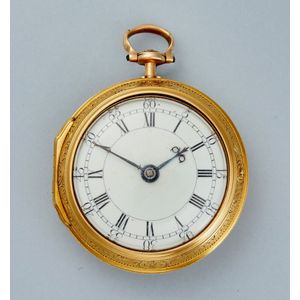18th Century William Webster Gold Verge Escapement Pocket Watch
You must be a subscriber, and be logged in to view price and dealer details.
Subscribe Now to view actual auction price for this item
When you subscribe, you have the option of setting the currency in which to display prices to $Au, $US, $NZ or Stg.
- Fusee - The fusee movement was used in clocks and pocket watches from the mid 17th century. The fusee is a cone shaped drum within the works that is linked to the barrel of the spring, usually by a length of chain.
As the mainspring loses its tension over time, the cone shaped barrel compensates for this by increasing the tension, by pulling the mainspring tighter, thus ensuring the time remains constant.
Use of the fusee in clocks was superseded by the "going barrel" in the mid 19th century and for pocket watches at the beginning of the 19th century.
The fusee continued to be used in marine chronometers until the 1970s. - Movement - The technical name for the workings of a clock or watch, and does not include the dial or case.
- Verso - Verso is the "back" side of a sheet of paper, art work, coin or medal. The front side is "recto".
- Verge Escapement - A verge escapement is an early mechanical escapement used in clocks and other timekeeping devices. It is an early form of the escapement mechanism, which is used to regulate the movement of the hands of a clock or watch. The verge escapement consists of a vertical shaft called the verge, which is mounted on the clock's main plate. Attached to the verge are two pallets, which engage with the teeth of the escape wheel. As the escape wheel turns, the pallets alternately lock and release it, allowing the movement of the clock to be regulated. The verge escapement was widely used in early mechanical clocks, but it was eventually replaced by the more accurate and reliable anchor escapement.
This item has been included into following indexes:
-
pocket watches, case type
- open face, gold / gold-plated case 1,289
- pair cased 143
- pocket watches, period - Georgian 240
Visually similar items

An 18ct gold open face pocket watch; white dial (small chip and hairline crack), black Roman numerals, subsidiary seconds dial on a lever movement signed Wm. McFerran, Manchester no. 45925. C - 1883. Wt. 93.5g.

A lady's 18ct gold open face pocket watch, white dial (some hairline cracks), with Roman numerals, push piece at one o'clock, in a finely engraved case, size 30 mm, working.

An antique Patek and Czapek gold pocket watch, key wind and key set Swiss cylinder movement, circular white dial with painted black Roman numerals, cuvette signed Patek Czapek Genewie number 71, 18ct gold case with engraved crest, 45 mm diameter

A lady' s gold openface pocket watch, circa 1895. 35 mm. Key wind. Unsigned movement. 18ct yellow gold.
